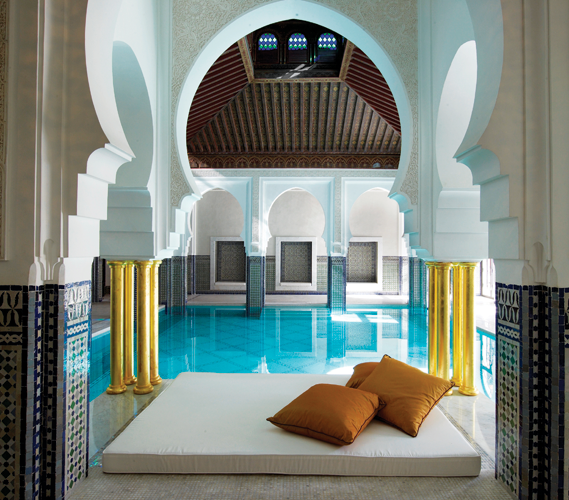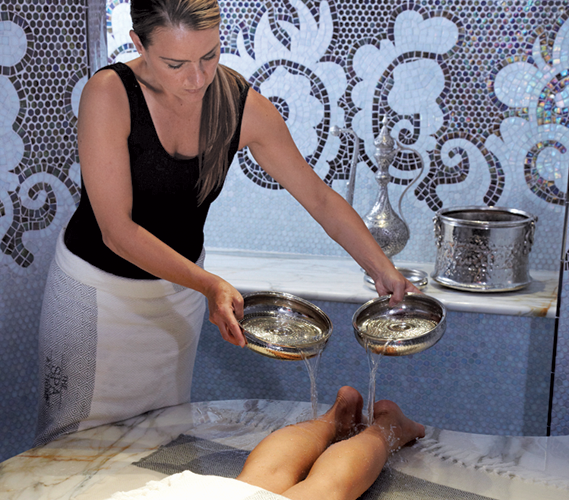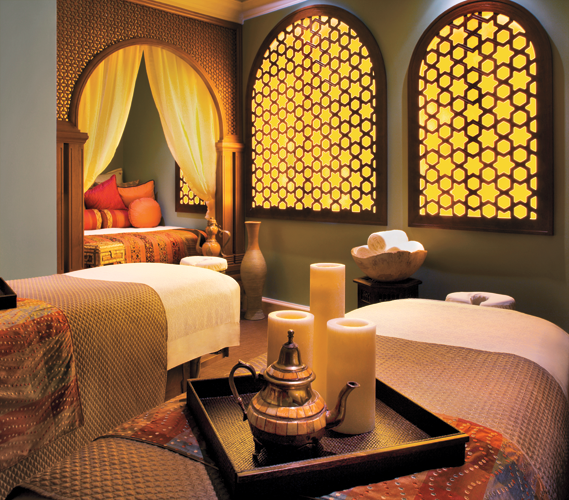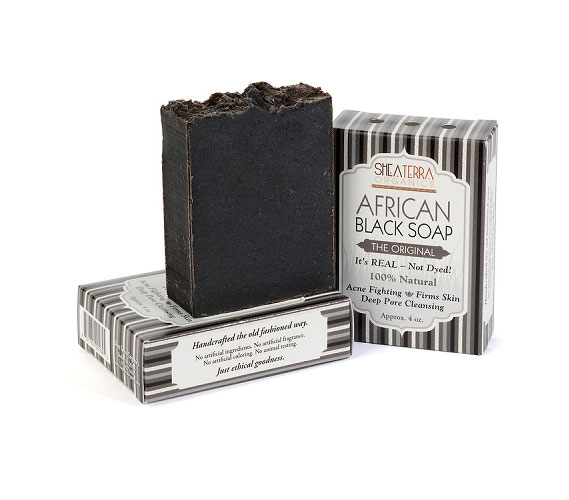
History Of The Moroccan Hammam
The Hammam, a public steam room and bath cleansing ritual, originated in Arabia where bath culture was once an integral part of the Roman lifestyle. Eventually popularized by Turkish natives, the ancient tradition later spread to different cultures throughout southern Europe and northern Africa, particularly Morocco.
Today, Moroccan natives pay a weekly visit to a local Hammam to partake in the ritual-based body treatment that includes cleansing, aromatherapy, detoxification and massage. “An ancient purification ritual that has both healing and transformative powers, the Moroccan Hammam encourages skin smoothing, increases circulation, stimulates the immune system, releases toxins, and is an excellent way to relax and melt away stress,” says Erin Stewart, spa director at Joya Spa. It’s a great way to purify the skin using key Moroccan ingredients such as black soap, rhassoul clay and argan oil.”
Royal Hammam Treatment – The Spa at La Mamounia, Marrakech, Morocco
This treatment offers the complete hammam experience including a relaxation steam room with eucalyptus scent, followed by a black soap exfoliation, ghassoul clay body wrap and an application of argan oil. The ritual concludes with a deluxe body massage.

Moroccan Hammam Treatment – The Spa at Trump at Trump SoHo, New York, New York
The Spa at Trump is home to the first authentic luxury hammam in Manhattan, featuring the personalized technique and service of the spa’s Hammam Attaché (a personal treatment guide) throughout the experience. This revitalizing therapy uses authentic Moroccan black soap and warm ghassoul clay for full-body exfoliation, detoxification and deep nourishment.

Moroccan Cleansing Retreat – Joya Spa at Montelucia Resort & Spa, Scottsdale, Arizona
Begin your experience with the taste of traditional Moroccan tea and then enjoy falling into deep relaxation as you are pampered with a rare volcanic body masque and exquisite foot treatment featuring exotic essential oils. A massage with an application of skin-smoothing argan oil follows to continue the bliss.

Red Flower Hammam Treatment – ONE Spa at Shutters On The Beach, Santa Monica, California
A deeply detoxifying experience, this therapeutic ritual features a spin on the standard through a vigorous citrus coffee body exfoliation, a purifying rhassoul clay wrap and a heated deep tissue massage. To finish, your skin is coated with shea butter and figs for a feeling of pure rejuvenation.

Looking to bring the Moroccan spa experience home? Try these products.
Black Soap
A mixture of oil, crushed Moroccan olives, salt and potash (manufactured salt containing potassium in water-soluble form), black soap originated in West Africa and is generally the first treatment in the traditional hammam ritual. Oftentimes referred to as “savon noir,” black soap is rich in vitamin E and is “antimicrobial, medicinal and detoxifying, as well as aromatic to the senses,” says Stewart. It deep cleans the skin, making it softer to prepare for exfoliation, and also helps reduce premature signs of aging.
We like this one from Shea Terra Organics because it is slightly efoliating and free of dyes. $8, sheaterraorganics.com

Skin Softener
Paraben-free and loaded with natural plant extracts and antioxidants, NEST Fragrances Moroccan Amber Body Wash gently cleanses and moisturizes. $28, nestfragrances.com

Fragrance Fix
Spray the femininely fragrant I Coloniali Light Body Essence with Moroccan Rose and Coriander all over the body for instant nourishment. $49, icoloniali-us.com

Rose Oil
Rose Oil, also known as rose otto, is a luxurious oil made from rosa damascena, or Moroccan rose. Considered the essential oil with the highest vibration (the impact of essential oils and plants on people’s feelings, state of mind and health), rose oil is recognized in aromatherapy for its stress-relieving and soothing properties, as well as its ability to make the skin glowy and smooth.
“Extracted from actual rose petals, the healing and balancing oil is especially suitable for sensitive, dry and aging skin,” says Mohamed Rzal, head of product development at REN Clean Skincare. “Rose water, a by-product of the oil, is also used in many beauty rituals as a cleanser and moisturizer, as well as an anti-aging treatment.” $48,renskincare.com

Rhassoul Clay
Moroccan Rhassoul clay, also known as ghassoul clay, is organically mined from ancient deposits deep within the Atlas Mountains in the Northeast region of Morocco,” says Stewart. “It can be used as a detoxifying cleanser, skin conditioner or body mask, and surpasses other clays because it contains the highest content of silica, magnesium, potassium and calcium.” Typically, the mineral-rich rhassoul clay comes in a smooth powder form and is blended with orange flower water or rose water to turn it into a sweet-smelling paste. “Mixed with rose water, ghassoul clay becomes a smooth paste that has purifying virtues and liberates toxins,” says Aude Koch, spa director at La Mamounia.

Argan Oil
For centuries, Moroccan women have used argan oil, the rarest of all oils, to preserve and enhance the beauty of their skin. Harvested from the argan tree, which grows exclusively in the Southwestern region of the country, argan oil possesses the highest nutritive quality of oils and is rich in antioxidants, essential fatty acids, vitamins and plant sterols. “Argan oil contains twice the amount of tocopherols (vitamin E) found in olive oil,” says Stewart. “It is a natural antioxidant and can stimulate intracellular oxygenation, which can increase the body’s immunity against disease and infection.”
In pre-modern times, Moroccan women used the oil topically to treat skin diseases and protect their skin from the harsh, dry climate of the desert. Also referred to as the “Gold of Morocco” because of its deep amber color, argan oil has long been considered an anti-aging treatment and is also known to aid in diminishing acne and stretch marks.
A rich yet lightweight oil for the face, body, hair and nails, Moroccanoil Pure Argan Oil instantly restores and rejuvenates. $50, moroccanoil.com


















